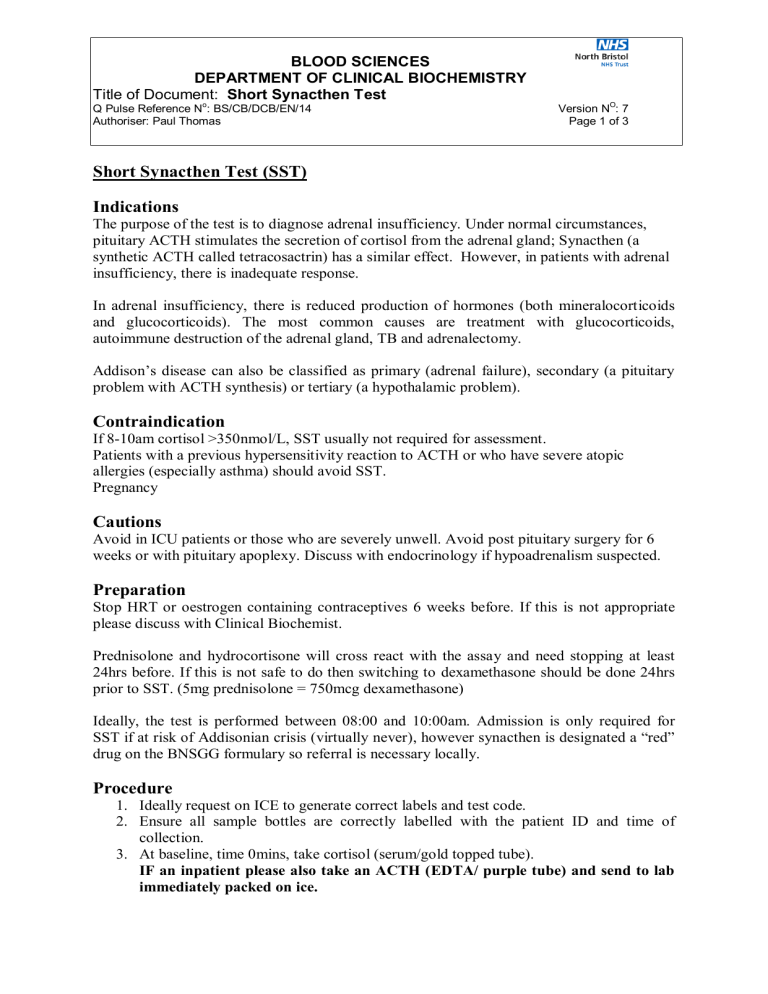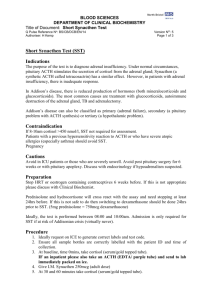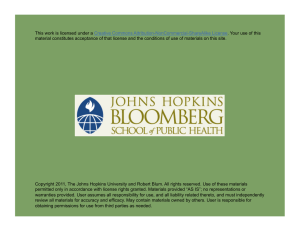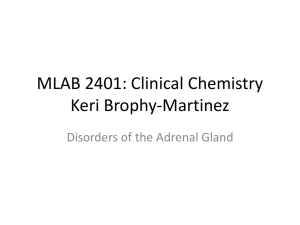
BLOOD SCIENCES DEPARTMENT OF CLINICAL BIOCHEMISTRY Title of Document: Short Synacthen Test Q Pulse Reference No: BS/CB/DCB/EN/14 Authoriser: Paul Thomas Version NO: 7 Page 1 of 3 Short Synacthen Test (SST) Indications The purpose of the test is to diagnose adrenal insufficiency. Under normal circumstances, pituitary ACTH stimulates the secretion of cortisol from the adrenal gland; Synacthen (a synthetic ACTH called tetracosactrin) has a similar effect. However, in patients with adrenal insufficiency, there is inadequate response. In adrenal insufficiency, there is reduced production of hormones (both mineralocorticoids and glucocorticoids). The most common causes are treatment with glucocorticoids, autoimmune destruction of the adrenal gland, TB and adrenalectomy. Addison’s disease can also be classified as primary (adrenal failure), secondary (a pituitary problem with ACTH synthesis) or tertiary (a hypothalamic problem). Contraindication If 8-10am cortisol >350nmol/L, SST usually not required for assessment. Patients with a previous hypersensitivity reaction to ACTH or who have severe atopic allergies (especially asthma) should avoid SST. Pregnancy Cautions Avoid in ICU patients or those who are severely unwell. Avoid post pituitary surgery for 6 weeks or with pituitary apoplexy. Discuss with endocrinology if hypoadrenalism suspected. Preparation Stop HRT or oestrogen containing contraceptives 6 weeks before. If this is not appropriate please discuss with Clinical Biochemist. Prednisolone and hydrocortisone will cross react with the assay and need stopping at least 24hrs before. If this is not safe to do then switching to dexamethasone should be done 24hrs prior to SST. (5mg prednisolone = 750mcg dexamethasone) Ideally, the test is performed between 08:00 and 10:00am. Admission is only required for SST if at risk of Addisonian crisis (virtually never), however synacthen is designated a “red” drug on the BNSGG formulary so referral is necessary locally. Procedure 1. Ideally request on ICE to generate correct labels and test code. 2. Ensure all sample bottles are correctly labelled with the patient ID and time of collection. 3. At baseline, time 0mins, take cortisol (serum/gold topped tube). IF an inpatient please also take an ACTH (EDTA/ purple tube) and send to lab immediately packed on ice. BLOOD SCIENCES DEPARTMENT OF CLINICAL BIOCHEMISTRY Title of Document: Short Synacthen Test Q Pulse Reference No: BS/CB/DCB/EN/14 Authoriser: Paul Thomas Version NO: 7 Page 2 of 3 4. Give I.M. Synacthen 250mcg (adult dose) 5. At 30 and 60 minutes take cortisol (serum/gold topped tube). 6. Send all the serum/gold topped tubes together to the lab, do not send them separately. Interpretation of Results 1. Basal Cortisol level should be greater than 180nmol/L 2. 30min or 60min Cortisol should be greater than 420nmol/L (whatever the basal level) 3. The increment should be at least 170nmol/L apart from in severely ill patients where adrenal output is already maximal. 4. If the patient is taking oestrogens cortisol should be greater than 640nmol/L If there is a suboptimal test and ACTH was sent to the lab it will then be measured to distinguish primary from secondary adrenal failure. This cannot be sent from primary care due to sampling requirements. · If impaired cortisol response, and ACTH >200ng/L then diagnosis is primary adrenal failure. · If ACTH <10ng/L then diagnosis is secondary adrenal failure Sensitivity and Specificity A normal cortisol response does not exclude adrenal failure, since impending adrenal failure might be associated with a much greater loss of zona glomerulosa function. The latter would be suggested by an elevated plasma renin activity. If equivocal result and no urgency, repeat test after a few weeks. Use in Congenital Adrenal Hyperplasia Diagnosis and characterisation of 21-hydroxylase deficiency and other causes of adrenal hyperplasia can use a Short Synacthen Test. SST should be done in the follicular phase because 17OH progesterone is increased after ovulation. On the samples taken for cortisol, 17- hydroxy progesterone (17OHP) should be requested. Response of 17-OH progesterone in suspected 21-hydroxylase deficiency: Marked rise after ACTH stimulation (>30nmol/L), which varies according to whether the patient is homozygous or heterozygous. Reference for nomogram: New et al., JCEM 57, 320326 (1983). Appendix 1: Hazard Data Hypersensitivity reactions: Synacthen rarely can provoke hypersensitivity reactions, which tend to be more severe (anaphylactic shock) in patients susceptible to atopic allergies (especially asthma). Hypersensitivity reactions may include skin reactions at the injection site, dizziness, nausea, vomiting, urticaria, pruritus, flushing, malaise, dyspnoea, and angioneurotic oedema. When hypersensitivity reactions occur, they tend to set in within 30 minutes after the injection. The patient should therefore be kept under observation during this time. BLOOD SCIENCES DEPARTMENT OF CLINICAL BIOCHEMISTRY Title of Document: Short Synacthen Test Q Pulse Reference No: BS/CB/DCB/EN/14 Authoriser: Paul Thomas Version NO: 7 Page 3 of 3 In case of anaphylaxis: Administer Adrenaline 0.5 mg as 0.5 ml of 0.1% solution (1:1000) by intramuscular injection, repeat adrenaline as necessary (every 5 minutes) followed by Hydrocortisone 200 mg i.v. and Chlorpheniramine 10 mg i.v., slowly over at least 1 min For further information see http://www.medicines.org.uk/emc/medicine/30030 Appendix 2: Laboratory issues Our cut off limits have been agreed after a review of the literature, discussion with Endocrinology and taking into account the published cut offs relating to our assay method (Roche). Recent published work shows that patients taking oestrogens have a significant positive bias post Synacthen due to increased cortisol binding globulin and its interference in the assay. Lower reference limits post Synacthen on contraceptive oral pill (COP) were quoted as 643nmol/l when measured by Mass spectrometry.(Clin Endo 2012 El Farhan et al.) The new GenII Roche assay for cortisol produces results closely aligned to MS method. Other factors that can alter CBG include: increased in pregnancy, COP, HRT and may be decreased in liver and renal disease. References 1. Method-specific serum cortisol responses to the adrenocorticotrophin test: comparison of gas chromatography-mass spectrometry and five automated immunoassays, Nadia El-Farhan*,†, Alan Pickett*, Clin Endo 2012 2. le Roux, Meeran K and Alaghband-Zadeh Is a 0900-h cortisol useful prior to a short Synacthen test in out patient assessment? Ann Clin Biochem 2002; 39: 148-50. 3. Abdu TAM, Elhadd TA, Neary R and Clayton RN. Comparison of the low dose short Synacthen test (1µg), the conventional dose short Synacthen test (250µg) and the insulin tolerance test for the assessment of the hypothalamo-pituitary-adrenal axis response in patients with pituitary disease. J Clin Endocrinol Metab 1999: 84; 838-43. 4. Walsh JP and Dayan CM. Role of biochemical assessment in the management of corticosteroid withdrawal. Ann Clin Biochem 2000: 37; 279-287. 5. Wallace I, Cunningham S and Lindsay J. The diagnosis and investigation of adrenal insufficiency in adults. Ann Clin Biochem 2009: 46; 351-67.




